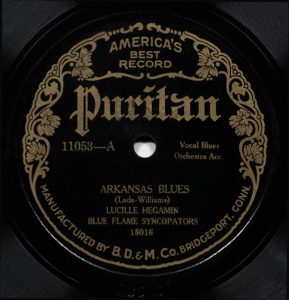[Posted by Henry Arneth, Special Collections Assistant. Henry is creating an inventory of our 78-rpm record collection, which numbers over 10,000 items!]
 In August of 1920 Mamie Smith entered OKeh Records’ New York recording studio with Perry Bradford & his Jazz Hounds. She recorded a composition by Bradford called “Crazy Blues” and started a revolution in music. With that song, she became the first African American woman to record a blues song. Before her, any blues material written by African American composers would be performed by white musicians and singers—filtering the music during a time of legal segregation to make it acceptable for a white audience. This song also launched the “Race Music” era that ended with World War II.
In August of 1920 Mamie Smith entered OKeh Records’ New York recording studio with Perry Bradford & his Jazz Hounds. She recorded a composition by Bradford called “Crazy Blues” and started a revolution in music. With that song, she became the first African American woman to record a blues song. Before her, any blues material written by African American composers would be performed by white musicians and singers—filtering the music during a time of legal segregation to make it acceptable for a white audience. This song also launched the “Race Music” era that ended with World War II.
Blues was always a popular music form; it had been published and recorded since 1914, with “St. Louis Blues” by W. C. Handy amid the earliest recordings. One of the most popular versions of the song features a young, pre-Decca Records Bing Crosby being backed up by Duke Ellington and his Famous Orchestra (Columbia #5503, 1932). What made Smith’s recording so groundbreaking is that she was a black woman, singing a black song, in a black style. And the song sold—well—to both black and white audiences. Furthermore, the recording also opened up a market previously ignored by the recording industry.
“Crazy Blues” did so well that a small label, Arto, decided to take a chance on an African American artist as well—Lucille Hegamin. Lucille Nelson Hegamin was born in Macon, Georgia, in 1894. She moved to Chicago, where she was known as the Georgia Peach. She married her pianist husband, Bill Hegamin, in 1914 and eventually moved to New York City where by 1919 she was performing in Harlem.[1] In the fall of 1920, she was in the recording studio.[2] Her first two sessions with Arto turned out two hits, making her not only the second black female blues singer, but also the second black pop music artist. Her hits were “The Jazzy Me Blues” & “Arkansas Blues” featured on Arto 9045 and Arto 9053, respectively.
Hegamin’s recordings sold so well that the matrices, the molds created from wax tablets—the original substance the music is etched into during a recording session—that the record companies would use to press records can be found on other labels, some associated with Arto and some not. The reason for using the matrices is that the same sound could be heard on a variety of labels marketed in different ways, from a high end shop or a dime store, and priced accordingly.
The way matrices can be traced is through an alpha-numeric code etched into the wax that is specific to the take. Each recording studio had its own code associated with it that can be used to identify each take and each pressing. This code is found in the area by the label called the runoff—it is the part of the record where the needle ends after the song is played. It is through these numbers that the various takes can be traced. The specific pressing of “Arkansas Blues” (Arto matrix number 18016) heard here (on Puritan 11053) can also be found on Banner Records (1014-A), Bell Records (P-53-A), Black Swan (2032-A), Claxtonola (40053-A), Famous (3045-A), Globe (7053-A), Hy-Tone (K-53-A), Paramount (20053-A), and Triangle (11052-A).[3] All the above records were pressed between 1920 and 1922. “Arkansas Blues” was one of the most popular recordings of 1921.
[1] Roke, Elizabeth; Lucille Hegamin Papers 1894-1969, Stuart A. Rose Manuscript, Archives, & Rare Book Library, Emory University, Atlanta, Georgia, 2010
[2] Komara, Ed & Peter Lee, eds; The Blues Encyclopedia; New York & Oxon, UK, Routledge, 2006; I:813
[3] Rust, Brian; Jazz and Ragtime Records (1897-1942) Volume 1: A-K; Denver, Colorado, Mainspring Press, 2002; 764
Tags: Music, Sound recordings
 A shout-out to Henry Arneth, our Special Collections Assistant, who spotted a great buy at a local auction house–five bound volumes of the Hartford Daily Courant dating from 1838-1843. Up to now we only had seven (7) individual issues dating from 1846-1887 in paper, but of course the main library has the entire run online–which comprise title changes: The Daily Courant (1837-1839) and the Hartford Daily Courant (1840-1887). As anyone will tell you who has handled period newspapers, though, leafing through the real thing and using it online are two very different experiences.
A shout-out to Henry Arneth, our Special Collections Assistant, who spotted a great buy at a local auction house–five bound volumes of the Hartford Daily Courant dating from 1838-1843. Up to now we only had seven (7) individual issues dating from 1846-1887 in paper, but of course the main library has the entire run online–which comprise title changes: The Daily Courant (1837-1839) and the Hartford Daily Courant (1840-1887). As anyone will tell you who has handled period newspapers, though, leafing through the real thing and using it online are two very different experiences.







